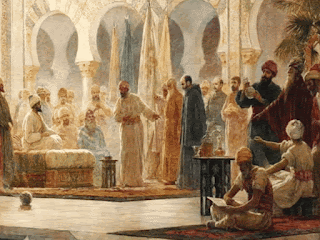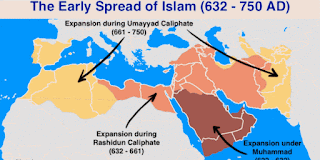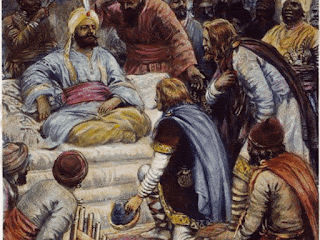History of the Islamic Golden Age
What is the Islamic Golden Age?
Who were the Major Figures of the Golden Age?
 |
Introduction to the Islamic Golden Age
Golden age era 8 to 14
 |
| spread of islam map |
History of Mohammedan era begin
Hijra to medina in 622 CE
five pillars of Islam names
Social condition of arabia before islam
Arabia was largely desert, and was growing less and less capable of supporting its population. The first conquests of the Arabs began as mere raids for plunder, and only turned into permanent occupation after experience had shown the weakness of the enemy. Suddenly, in the course of some twenty years, men accustomed to all the hardships of a meagre existence on the fringe of the desert found themselves masters of some of the richest regions of the world, able to enjoy every luxury and to acquire all the refinements of an ancient civilization.
They withstood the temptations of this transformation better than most of the Northern barbarians had done. As they had acquired their empire without much severe fighting, there had been little destruction, and the civil administration was kept on almost unchanged. Both in Persia and in the Byzantine Empire, the civil government had been highly organized. The Arab tribesmen, at first, understood nothing of its complications, and perforce accepted the services of the trained men whom they found in charge.
These men, for the most part, showed no reluctance to serve under their new masters. Indeed, the change made their work easier, since taxation was lightened very considerably. The populations, moreover, in order to escape the tribute, very largely abandoned Christianity for Islam.
four caliphs of Islam
The arab empire and the caliphates
what is an absolute monarchy ? The Arab Empire was an absolute monarchy, under the caliph, who was the successor of the Prophet, and inherited much of his holiness. The caliphate was nominally elective, but soon became hereditary. The first dynasty, that of the Umayyads, which lasted till 750, was founded by men whose acceptance of Mahomet was purely political, and it remained always opposed to the more fanatical among the faithful.
The Arabs, although they conquered a great part of the world in the name of a new religion, were not a very religious race; the motive of their conquests was plunder and wealth rather than religion. It was only in virtue of their lack of fanaticism that a handful of warriors were able to govern, without much difficulty, vast populations of higher civilization and alien religion.
split in Islam religion
why there was a split in Islam resulted in the recreation of the two different sects ? The Persians, on the contrary, have been, from the earliest times, deeply religious and highly speculative. After their conversion, they made out of Islam something much more interesting, more religious, and more philosophical, than had been imagined by the Prophet and his kinsmen.
why did sunni and shia split ?
Ever since the death of Mahomet's son-in-law Ali in 661, Mohammedans have been divided into two sects, the Sunni and the Shiah. The former is the larger; the latter follows Ali, and considers the Umayyad dynasty to have been usurpers.
The Persians have always belonged to the Shiah sect. Largely by Persian influence, the Umayyads were at last overthrown, and succeeded by the Abbasids, who represented Persian interests. The change was marked by the removal of the capital from Damascus to Baghdad.
Islamic empire facts
A brief timeline prepares this preparation. The prophet Muhammad died in 632 CE, succeeded by Abu Bakr. The latter’s appointment by the elders at Medina angered those who expected to see Muhammad’s cousin and son-in-law, Ali, become Caliph. Ali eventually became the fourth Caliph, but the damage had been done; the rift that was to split Sunni from Shi‘a was permanently opened by this disagreement over the succession.
achievements of umayyad dynasty
Ali’s appointment was opposed by the Umayyad clan, and he was murdered in 661, to be succeeded by his son Hasan, who abdicated that same year, at which point the Umayyads took control. Under them the Empire expanded hugely and rapidly, until it touched the Atlantic shores in the west and the borders of China in the east.
The Abbasids were, politically, more in favour of the fanatics than the Umayyads had been. They did not, however, acquire the whole of the empire. One member of the Umayyad family escaped the general massacre, fled to Spain, and was there acknowledged as the legitimate ruler. From that time on, Spain was independent of the rest of the Mohammedan world.
Under the early Abbasids the caliphate attained its greatest splendour. The best known of them is Harun-al-Rashid (d. 809), who was a contemporary of Charlemagne and the Empress Irene and is known to every one in legendary form through the Arabian Nights.
His court was a brilliant centre of luxury, poetry, and learning; his revenue was enormous; his empire stretched from the Straits of Gibraltar to the Indus. His will was absolute; he was habitually accompanied by the executioner, who performed his office at a nod from the caliph. This splendour, however, was short-lived.
His successor made the mistake of composing his army mainly of Turks, who were insubordinate, and soon reduced the caliph to a cipher, to be blinded or murdered whenever the soldiery grew tired of him. Nevertheless, the caliphate lingered on; the last caliph of the Abbasid dynasty was put to death by the Mongols in 1256, along with 800,000 of the inhabitants of Baghdad.
arab merchants history
One of the best features of the Arab economy was agriculture, particularly the skilful use of irrigation, which they learnt from living where water is scarce. To this day Spanish agriculture profits by Arab irrigation works.
A history of Islamic philosophy
Some therefore choose to demarcate this slice of philosophy’s history as ‘Philosophy in the Islamic World’. Despite the persistence of an association with a religion it is like calling philosophy in Europe ‘Philosophy in the Christian World’, which would not be true for nearly half of the history of Western philosophy it is a less inaccurate option, and its adoption as an historic geographical label of convenience is acceptable.
‘Arabic–Persian’, this time relating to the languages in which the philosophy was written. The virtue of this is that it keeps in mind the fact, significant for philosophy in the Western tradition, that it was via Arabic that some of the key texts of antiquity were preserved and recovered.
Islamic golden age philosophy
What follows here is an account of the leading thinkers in the Islamic world in the period between al-Kindi (c.801–73 CE) and Ibn Rushd (Averroes, 1126–98 CE). The focus here is on the treatment of questions of strictly philosophical interest, not least in connection with their influence on debates, just alluded to, in the wider philosophical community of their time, through translations from Arabic into Latin and the use of texts such as Averroes’ commentaries on Aristotle in the universities of Europe.If this seems too sharp a demarcation, consider this: if you accept as an unquestionable basis the existence and continuing interested activity of an omnipotent, benevolent, eternal and supernatural creator, then you have certain immediate commitments that are not open to discussion.
For example: that the world has a beginning in time and certain tricky problems to solve, for example: the existence of moral and natural evil, which on the face of it would have to be viewed as ultimately the responsibility of the being in question because it caused everything to exist, but which contradicts that being’s goodness and benevolence, typically supposed to be total. Or: if the being is One, because Oneness is perfect, complete, self-consistent and self-subsistent, why are there many things? why would such a being create or emanate pluralities?
Or: if reality is a continuous emanation (in Islamic thought, fayd) from the divine being by some necessity of its nature, does that entail that free will does not exist in the universe? If the being emanates the universe by its own free will, why does it do so, given the imperfection of plurality and the evil that results?
Finding solutions to these problems is a matter for theology and theodicy; a philosophical approach would question the conceptual robustness of the ontology (the existence of a being or beings of the kind at issue) which creates such difficulties in the first place.
Greek philosophy: impact on Islamic philosophy
It is interesting but futile to speculate what impact the humanistic culture of classical antiquity might have had on Islamic culture had it survived in any quantity. We know the effect its rediscovery had on the European Renaissance. Might something similar have happened? Nevertheless what chiefly stood out, as Ibn al-Nadim’s catalogue shows, was Aristotle. Aristotle was philosophy to almost all the Muslim scholars (al-Farabi, a Platonist, was the exception), and even parts of the Neoplatonist corpus were credited to him.
By the time of the Arab conquest, the chief centres of philosophy in the Christian Hellenic world were Athens a very pale imitation of its former glory and, much more importantly, Alexandria, which fell to the Muslim forces of Ibn al-As in September 642.
By one of the strange reversals of history Aristotle, whose philosophy had only just managed to survive, centuries before, by the skin of its teeth , had become the most admired and studied figure at Alexandria in the period directly before this event, while Plato had gone into relative eclipse.
In any case the Neoplatonism that preserved ideas from Plato was by then a syncretistic form of theosophy (a family of views claiming the possibility of direct intuitive encounter with and knowledge of a deity), having absorbed other strands of thought and emphasized the more mystical Plato of the Timaeus. So the view that Arab scholars had of the history of Greek philosophy was idiosyncratic.
Another conduit of philosophy into the Islamic world was Persia. The Emperor Justinian closed the Academy in Athens in 529 CE, confiscating its property and expelling the philosophers. They went as refugees to Persia, to the court of Chosroes Anushirvan (Khosrow I, 501–79 CE), King of the Sassanian Empire, who had a reputation for wisdom.
Little is known of Athenians’ activity there, but a number of Greek philosophical texts were incorporated into the collection of Zoroastrian texts, the Avesta, over the following decades of that century, which demonstrates that their presence left a mark.
They would not have been introducing anything unfamiliar to Persian scholars, though, because intercourse between the Greek and Persian worlds had persisted for more than a thousand years by that point, so perhaps what they achieved was an increase in interest in the philosophical tradition they represented, enough to recommend some of the texts they brought with them to the Avesta’s editors.
Some final preparatory remarks are required, concerning the theological background to the rise of philosophy proper in the Islamic world.
Mu‘tazilite
In this environment of learning the theology, kalam, encouraged by the ruling house was Mu‘tazilite, which promoted reason and evidence as adjuncts to faith. ‘Mu‘tazili’ means ‘withdrawer’, one who withdraws that is, one who withholds judgment, who sees two sides of the question, who uses rational and evidential tests in evaluating arguments.
The Mu'tazila – literally 'those who withdraw themselves' – movement was founded by Wasil bin 'Ata' in the second century AH (eighth century ad).
While the Mu‘tazila theology was ascendant, the Sunni–Shi‘a split was not especially serious, and it was possible for thinkers to question orthodoxy, disagree with one another without fear and freely debate difficult points in kalam.
A significant aspect of the rationalist and evidentialist approach of the Mu‘tazilites was that it provided a means of distinguishing between genuine and fake teachings and teachers, and between true and false beliefs which of course mattered because true beliefs are what get the believer to heaven.
The Ash‘ari school became, and is still, the most important of the Sunni theological schools (it is sometimes described as the ‘Sunni orthodoxy’). The Mu‘tazila remained influential among Shi‘a, and is today regarded as authoritative by the Zaydi Shi‘a school of law.
Islamic philosophy has mainly been associated with Shi‘a Islam as a result; the Sunni schools, based on the ideal of following the ‘tradition of Muhammad and the consensus of the ummah [community]’, are inhospitable to philosophizing and cleave instead to orthodoxy.
Bibliography
A History of Western Philosophy Book by Bertrand Russell
The-history-of-philosophy-by-a.-c.-grayling
Philosophy: Selected Readings Presenting the Interactive Discourses among the Major Figures, 2nd edn, Peterborough, ON: Broadview Press, 2006
Koterski, J. W., An Introduction to Medieval Philosophy: Basic Concepts, Chichester: Wiley-Blackwell, 2009







Comments
Post a Comment